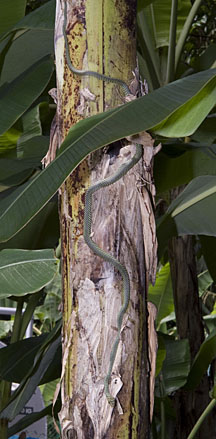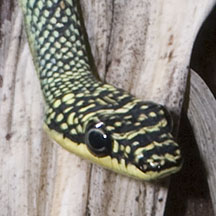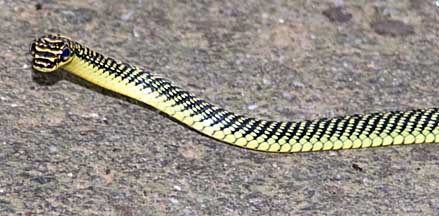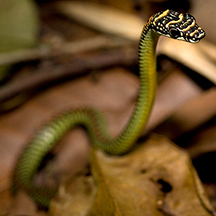 |
|
| snakes text index | photo index |
| Phylum Chordata > Subphylum Vertebrata > Class Reptilia > shore snakes |
| Paradise
tree snake Chrysopelea paradisi Family Colubridae updated Oct 2016 Where seen? This beautiful snake is often seen in our forests as well as coastal forests. According to Nick Baker, in Singapore, commonly encountered in a variety of habitats including mangrove, secondary forest, and parks and gardens. An adept climber, its favoured haunt is the crown of coconut palms. Features: To about 1.2m long. A long slender snake with a cylindrical body. The head is relatively flat and distinct from body with yellow spots in five bands. Colours upperside black 'netting' pattern on golden yellow or green, sometimes with a row of red flowery pattern along the centre. It is mildly venomous. Soaring Serpents: Also called the 'Flying tree snake' they don't actually fly or glide but instead, perform a sort of parachute jump. To do this, they "suck in their guts" to form a U-shaped half-cylinder along the entire length of their bodies. The outer edges of their belly scales are rigid while the central portion of their belly scales fold upwards. This concave surface acts like a parachute, and increases air resistance to prolong the "flight". The snake has some degree of control, undulating through the air as if swimming, holding its tail rigidly upwards and twisting the tail from side to side for balance. In this way, they can cross as much as 100m, although they crash land clumsily. This allows them to cross long distances quickly, perhaps to catch prey, escape predators or simply to move around. They generally parachute from tree to tree, but sometimes from tree to ground. To achieve this feat, they first have to climb up a tall launch point, which is not a problem as they have ridged (keeled) belly scales to help them grip vertical surfaces. What does it eat? According to Nick Baker, it hunts small prey, mainly tree-dwelling lizards. Their venom is mild, and affects only their small prey. Their fangs are short, located at the back of the mouth, and are not hypodermic-like; the venom is injected through grooves in the fangs. Thus, they can only inject venom into prey that is well inside their mouths. Flying babies: Little is known about their breeding habits. They lay 6-11 eggs, hatchlings are 15-20cm long and have the same pattern as the adults but their colours are brighter. |
 Pulau Ubin, Oct 03  Yellow spots form five bands across the head. |
 This one landed on the road from a tall tree. Pulau Ubin, Jan 11 |
||
| Paradise tree snakes on Singapore shores |
| Photos of Paradise tree snakes for free download from wildsingapore flickr |
| Distribution in Singapore on this wildsingapore flickr map |
|
Links
References
|
|
|
